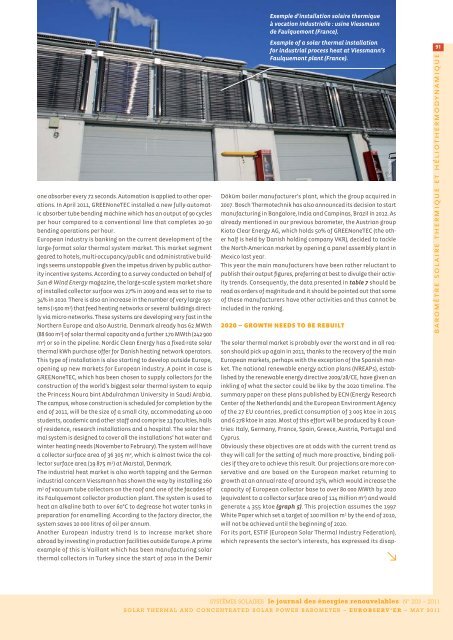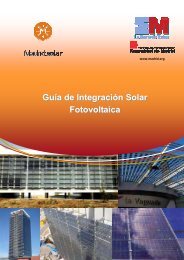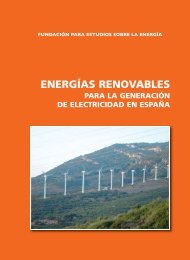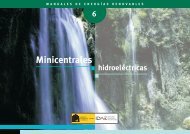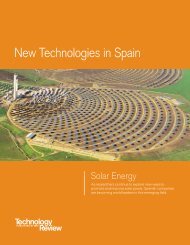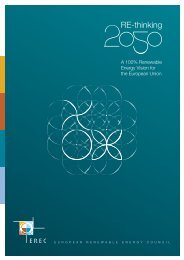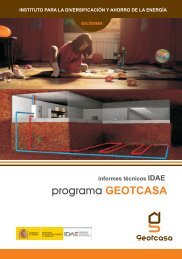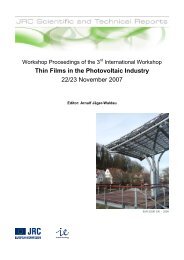BAROMÃTRE SOLAIRE THERMIQUE ET - EurObserv'ER
BAROMÃTRE SOLAIRE THERMIQUE ET - EurObserv'ER
BAROMÃTRE SOLAIRE THERMIQUE ET - EurObserv'ER
Create successful ePaper yourself
Turn your PDF publications into a flip-book with our unique Google optimized e-Paper software.
91baromètre solaire thermique et héliothermodynamique<br />
Exemple d’installation solaire thermique<br />
à vocation industrielle : usine Viessmann<br />
de Faulquemont (France).<br />
Example of a solar thermal installation<br />
for industrial process heat at Viessmann’s<br />
Faulquemont plant (France).<br />
Viessmann<br />
one absorber every 72 seconds. Automation is applied to other operations.<br />
In April 2011, GREENoneTEC installed a new fully-automatic<br />
absorber tube bending machine which has an output of 90 cycles<br />
per hour compared to a conventional line that completes 20-30<br />
bending operations per hour.<br />
European industry is banking on the current development of the<br />
large-format solar thermal system market. This market segment<br />
geared to hotels, multi-occupancy/public and administrative buildings<br />
seems unstoppable given the impetus driven by public authority<br />
incentive systems. According to a survey conducted on behalf of<br />
Sun & Wind Energy magazine, the large-scale system market share<br />
of installed collector surface was 27% in 2009 and was set to rise to<br />
34% in 2010. There is also an increase in the number of very large systems<br />
(>500 m 2 ) that feed heating networks or several buildings directly<br />
via micro-networks. These systems are developing very fast in the<br />
Northern Europe and also Austria. Denmark already has 62 MWth<br />
(88 600 m 2 ) of solar thermal capacity and a further 170 MWth (242 900<br />
m 2 ) or so in the pipeline. Nordic Clean Energy has a fixed-rate solar<br />
thermal kWh purchase offer for Danish heating network operators.<br />
This type of installation is also starting to develop outside Europe,<br />
opening up new markets for European industry. A point in case is<br />
GREENoneTEC, which has been chosen to supply collectors for the<br />
construction of the world’s biggest solar thermal system to equip<br />
the Princess Noura bint Abdulrahman University in Saudi Arabia.<br />
The campus, whose construction is scheduled for completion by the<br />
end of 2011, will be the size of a small city, accommodating 40 000<br />
students, academic and other staff and comprise 13 faculties, halls<br />
of residence, research installations and a hospital. The solar thermal<br />
system is designed to cover all the installations’ hot water and<br />
winter hea ting needs (November to February). The system will have<br />
a collector surface area of 36 305 m 2 , which is almost twice the collector<br />
surface area (19 875 m 2 ) at Marstal, Denmark.<br />
The industrial heat market is also worth tapping and the German<br />
industrial concern Viessmann has shown the way by installing 260<br />
m 2 of vacuum tube collectors on the roof and one of the facades of<br />
its Faulquemont collector production plant. The system is used to<br />
heat an alkaline bath to over 60°C to degrease hot water tanks in<br />
preparation for enamelling. According to the factory director, the<br />
system saves 10 000 litres of oil per annum.<br />
Another European industry trend is to increase market share<br />
abroad by investing in production facilities outside Europe. A prime<br />
example of this is Vaillant which has been manufacturing solar<br />
thermal collectors in Turkey since the start of 2010 in the Demir<br />
Döküm boiler manufacturer’s plant, which the group acquired in<br />
2007. Bosch Thermotechnik has also announced its decision to start<br />
manufacturing in Bangalore, India and Cam pinas, Brazil in 2012. As<br />
already mentioned in our previous barometer, the Austrian group<br />
Kioto Clear Energy AG, which holds 50% of GREENoneTEC (the other<br />
half is held by Danish holding company VKR), decided to tackle<br />
the North-American market by opening a panel assembly plant in<br />
Mexico last year.<br />
This year the main manufacturers have been rather reluctant to<br />
publish their output figures, preferring at best to divulge their activity<br />
trends. Consequently, the data presented in table 7 should be<br />
read as orders of magnitude and it should be pointed out that some<br />
of these manufacturers have other activities and thus cannot be<br />
included in the ranking.<br />
2020 – growth needs to be rebuilt<br />
The solar thermal market is probably over the worst and in all reason<br />
should pick up again in 2011, thanks to the recovery of the main<br />
European markets, perhaps with the exception of the Spanish market.<br />
The national renewable energy action plans (NREAPs), established<br />
by the renewable energy directive 2009/28/CE, have given an<br />
inkling of what the sector could be like by the 2020 timeline. The<br />
summary paper on these plans published by ECN (Energy Research<br />
Center of the Netherlands) and the European Environment Agency<br />
of the 27 EU countries, predict consumption of 3 005 ktoe in 2015<br />
and 6 278 ktoe in 2020. Most of this effort will be produced by 8 countries:<br />
Italy, Germany, France, Spain, Greece, Austria, Portugal and<br />
Cyprus.<br />
Obviously these objectives are at odds with the current trend as<br />
they will call for the setting of much more proactive, binding policies<br />
if they are to achieve this result. Our projections are more conservative<br />
and are based on the European market returning to<br />
growth at an annual rate of around 15%, which would increase the<br />
capacity of European collector base to over 80 000 MWth by 2020<br />
(equivalent to a collector surface area of 114 million m 2 ) and would<br />
generate 4 355 ktoe (graph 5). This projection assumes the 1997<br />
White Paper which set a target of 100 million m 2 by the end of 2010,<br />
will not be achieved until the beginning of 2020.<br />
For its part, ESTIF (European Solar Thermal Industry Federation),<br />
which represents the sector’s interests, has expressed its disap-<br />
SYSTÈMES <strong>SOLAIRE</strong>S le journal des énergies renouvelables N° 203 – 2011<br />
SOLAR THERMAL AND CONCENTRATED SOLAR POWER BAROM<strong>ET</strong>ER – EUROBSERV’ER – MAY 2011


